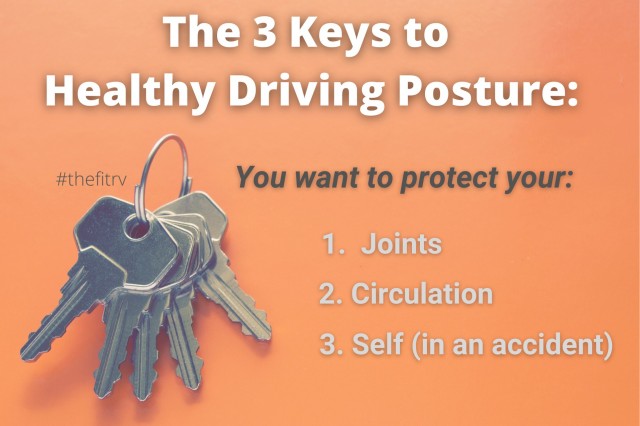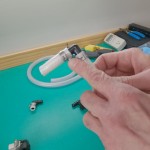This post may contain affiliate links.
The way you sit in your drivers seat can either mean a joyful drive or a miserable one.
As RVers we can spend long stretches of time behind the wheel. The trouble with that is, our bodies were designed to move. If we are static for long durations, our muscles are no longer acting like sponges… squeezing out blood with contractions, and soaking it back up with relaxation. Besides compromising our circulation, our driving posture places our joints in more vulnerable positions. This is why it’s so important to take the time to set up your seat. You want your driving posture at its most optimal to ensure you’re protecting 3 things: joints, circulation, and safety.

I dumped a whole lot on you in the video, but it really does come down the 5 basic steps I’ve listed out below. As long as you keep in mind the motivation behind the adjustments, like keeping your joints as open and neutralized as possible for both less strain on them AND better circulation, then the rest of it should start to make sense. If you still have questions after reading through the steps, feel free to leave comments below!
The FitRV’s 5 Steps for Healthy Driving Posture
STEP #1: Adjusting Your Distance From the Steering Wheel
🟩 Move seat forward enough so that your heel remains down when depressing either pedal.
🟩 Knees should be bent around 120 degrees even when the pedals are depressed. (Any less than that decreases leg circulation.)
STEP #2: Adjusting Your Bottom Seat Cushion
🟩 Make sure your hips and knees are either in line, or your knees can be lower than hips. (This opens your hips for better circulation and places less strain on low back).
🟩 Assure that you feel equal pressure all along the backs of your thighs. (If not, you might want to consider adding a wedge cushion.)
🟩 Do the 2-finger measurement test. Place 2 fingers on the back of your knee to see if you’ve got enough space there so the seat edge is not cutting off your circulation. (Shorter people, you may need to add a back rest cushion to achieve this.)
STEP #3: Adjusting Your Back Rest
🟩 Recline the back rest to an angle of 100-110 degrees. (This improves circulation through your hips and decreases pressure on your spine. Reclining any more than that places strain on your neck.)
🟩 Adjust the lumbar support so you feel even pressure all along your back. (If you’re unable to adjust your seat so you feel even pressure, consider adding a lumbar cushion.)
STEP #4: Adjusting Your Steering Wheel
🟩 Bring the steering wheel down and toward you to lessen the strain on your shoulders, neck, and upper back.
🟩 Ensure your shoulders remain against the backrest when you’re holding the wheel, and your elbows are not locked out.
🟩 Hold the steering wheel at 9 and 3 (or lower if you can do so safely) to take strain of your shoulders, neck, and upper back.
🟩 Be symmetrical, so both hands are holding the wheel in the same way. Don’t drive with one hand on top of wheel. (That forces your shoulder off the back rest and is taxing on your spine. Plus it’s less safe.)
🟩 Keep your wrists neutral (straight) as much as you can. Over-flexing or extending them for long periods causes strain on the muscles and ligaments, and it cuts off circulation to the hands.
STEP #5: Adjusting Your Head Rest
🟩 Raise the top of the headrest between the top of your ears and the top of your head.
🟩 Ensure the back of your head comes in contact with it comfortably.
🟩 If you can do so comfortably, use it occasionally while driving! (It gives your neck a break from holding up your head.)
And then of course, there’s the common sense things, like taking your wallet out of your back pocket, taking frequent driving breaks, switching drivers if possible, and limiting how much driving you do in a day… all of that will also play a role on how well you feel coming out of the drive. That’s what this whole thing is about anyways, feeling energized, healthy, and ready to enjoy the adventure!
Happy RVing, all!











Thanks Stef, very informative, and good explanations as to why. I do some of them, but never thought of “all” the seat adjustments and the why’s.
You’re the best!
Awesome! Glad it was a useful vid for you… if for nothing else but to confirm you’re already doing it right! Happy (and healthy) travels, Don!
Great tips Stef! Not only should we NOT do 10 and 2 because of back strain…but also AIR BAGS. 🙂 Even NHTSA no longer recommends 10 and 2. In the RAM Promaster low hand position is KEY. 🙂 A 9 and 3 grip is OK. But in the Promaster I would go as low as 8 and 4.
Excellent point. Not only healthier, but safer with air bags. Lower your hands, folks!!! xo
Thank you for this excellent checklist — we will be doing this ASAP!
Yayyy! Your body will thank you! xo
Finally, an explanation of what I should be doing. WooHoo!!!
Hey, I got another idea. How about explaining certain pains we get while driving (and the kids don’t count 😉 ) and what we might be doing wrong. I.E. a burning sensation by where the neck and shoulder meet or sharp pain in thigh of left leg. I can’t figure wh a particular pain is . occurring. I too, am 6’4″ and find I end up slouching which doesn’t help. Anyway, Thanks for the insight!!!
Hi Rick!!! The trouble with explaining pains is there can be so many different root causes! Like the burning sensation between neck/shoulder… that could be a soft tissue thing, maybe a tear in the rotator cuff, or just some generalized inflammation, or it’s possible it’s coming from an issue in the cervical spine. The best thing you can do no matter the root cause is get yourself close to neutral following the suggestions I gave in this vid. Now, if you have low back or hip injuries, I may suggest reclining the back rest a little more to open up the hips more. But then we start compromising your neck and making that more vulnerable. So, in that case I’d suggest trying it and seeing how your neck responds. If all goes okay, keep the seat reclined! For you though, as tall as you are there’s only so much reclining and getting the seat back you can do, as seats just aren’t designed for tall people. Do what you can to avoid slouching in your seat (I know, easier said than done when you’re tall lol), and make sure you stop frequently! xo
I must confess, our Mitsubishi Fuso cab-over truck based camper driver’s seat is heavenly! I liken it to a padded dining room table seat. Since I sit upright with my feet on the floor, I can drive for hours without discomfort. Unfortunately my daily driver, a GMC Sierra pickup truck makes me sit where my legs are forward and the back of my legs take all the weight. I can only sit in my GMC for an hour before needing to get out and stretch.
Sounds like your body shape is more compatible with the design of the truck camper’s seat. Good job stopping every hour in the GMC; keep doing that! And hopefully you can try to apply some of the tips to your GMC seat too, perhaps something in there will help? Either that, or go camping more! 😉 xo
Hi Stef, great advice, thank you I will revise some adjustments.
Did you notice if your seat is dead center in front of the steering ? I noticed on my 2018 ProMaster also outfitted with FCA swivel seats that the driver seat is positioned about one inch off center of the steering , towards the passenger side.
At first it bothered me having invested in a RV, until I discovered that many cars also have their seats offset from the center of the steering. So when I drive my ProMaster at 10 & 2 O’ Clock my arms are not reaching out the same distance and I need to drive at 10 & 3 O’ Clock to compensate.
Regards from Canada, borders are still closed for non essential travels by road.
Paul
How interesting, Paul, I haven’t noticed that! Though that certainly doesn’t mean ours isn’t an inch off; I’ll have to pay better attention next time I’m out in Lance and will come back and report if it is a little off! Stay well, Paul!
Nice succint coverage of the topic.
All great tips, Stef! But, when you’re 6’5″ like I am, you know that the only adjustment possible is all the way back, all the way down and reclined pretty well so you can keep your head off the headliner and you can see under the roof/windshield line. (I have to lean forward and look under the roofline to see stoplights.) The addition of any aftermarket pads or bolsters only makes it worse. And I have no clue why all manufacturers don’t make tilt AND telescope standard equipment. Just having one or the other merely messes up your body mechanics even more. Ah, well, everything is “one size fits all!” Thanks for the vids! Keep up the good work you two! And stay safe!
Yep. Seats are definitely not designed for tall people. I’m sure you’re used to doing what you can, but for you, many of the things we’re trying to avoid, like overly bent knees and hips, are going to be extremely challenging to achieve… ESPECIALLY when the seats offer very few adjustments. Frequent stops are going to be your best friend on long drives! Be well, Uncle Lar! xo
Thanks, Stef! That’s all we’ve got! Haha! (BTW – You should see me in a Lotus Europa!)